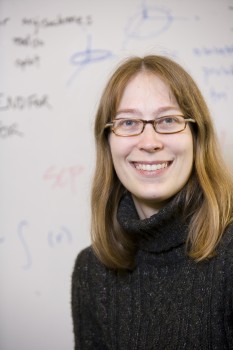Astronomer Beth Willman Joins Faculty

Details
Ultra-faint dwarf galaxies, the dimmest galaxies in the known universe, are a hot topic in astronomy. In fact, half of the 23 known satellite galaxies of the Milky Way were only discovered in the past few years. And one of those galaxies, Willman 1, is named for Haverford's new assistant professor of astronomy and physics, Beth Willman, who discovered it in 2005.
Willman is also part of a team of scientists who have been using the velocities of the stars in nearby dwarf galaxies to measure their masses. In September, the team published a paper in Astrophysical Journal on the dwarf Segue 1. Their conclusion: It may be the most dark-matter dominated galaxy yet found.
“Dwarf galaxies like Segue 1 and Willman 1 could be of key importance to comprehending structure formation and evolution in the universe,” says Willman. They could also, she adds,“have far reaching implications for understanding the formation of galaxies and the nature of dark matter.”
Willman, who received her B.A. in astrophysics at Columbia University and a Ph.D. in astronomy at the University of Washington, has been a James Arthur Fellow at the Center for Cosmology and Particle Physics, and a Clay Fellow at the Harvard-Smithsonian Center for Astrophysics. Her research focus is Near Field Cosmology, a field she helped kick start with her dwarf galaxy discoveries.
In her first semester at Haverford, Willman is teaching a course in modern Galactic astronomy which combines a lecture format with stints in the computer lab and independent research projects.“I'm really focused on giving students the techniques and tools they need, not only to be a research astronomer, but that could be applicable to physics and other fields,” says Willman. As part of that effort, Willman will give students the chance to participate in planning for the Large Synoptic Survey Telescope (LSST).“It's the next-generation big survey on the ground,” she says of the project, which will combine the largest digital camera ever built (3200 megapixels) with an 8.4m telescope to image faint objects across the sky.
“It's scheduled to go on line in 2014 and I am part of the team planning the Milky Way science cases,” Willman says.“I want the students to help figure out what are some of the technical needs for the telescope if we want to study the Milky Way. I think it will be cool for them to see how these long time frame, big-money science projects with lots of participants get planned.”
Focused on math and computers in high school, Willman says she didn't find her way to astronomy until her undergraduate years.“I thought astronomy was just naming stars and planets. But I learned from the faculty at Columbia that astronomy is just physics applied to the sky.”
Willman credits her undergraduate research advisor for her move into teaching.“That's who really inspired me,” she says.“Though I am really driven to do research, student mentoring is a big priority for me. I need that to feel like I'm a happy scientist.”
--Eils Lotozo



